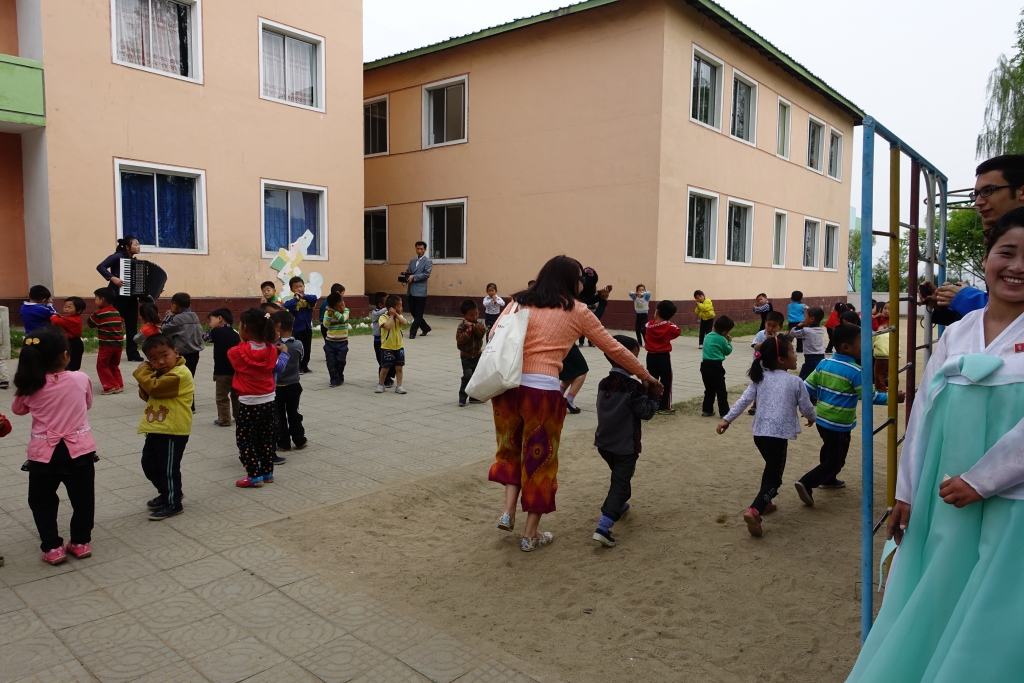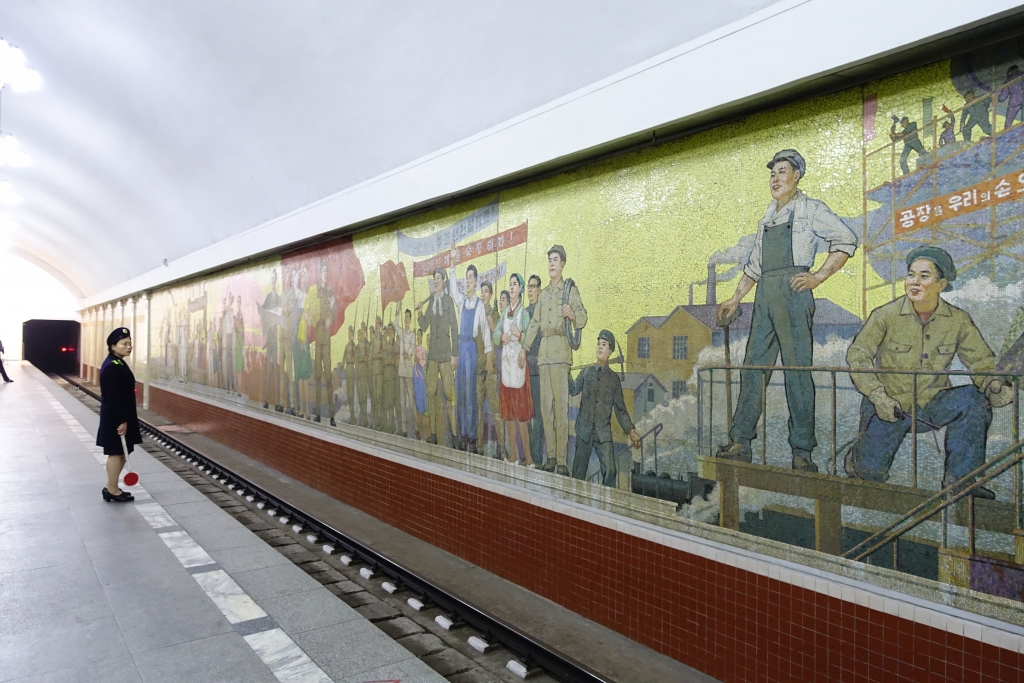Everyone wears a pin with the Dear Leader’s face on it. In a communist place where the individual means very little and people are taught to work for the success of the country, nearly everybody dresses similarly, wearing shades of grey, olive, or navy. However, there is a tiny bit of individuality that shines through once in a while. Sometimes you might see a person wearing a baseball cap or a shirt with a bit of color on it, and there’s always those ornate umbrellas that some of the upper class women carry around.
Navigation:
Our tour group boarded the bus in the morning of the third day and we headed towards the Cooperative Farm and then the West Sea Barrage. It was rush hour in Pyongyang; there were many people walking or biking and buses and trams were packed. However, I counted 12 other cars on the main street that we were driving through.
We turned onto one of the other gigantic main roads in the city and headed towards its outskirts. The road was at least five lanes wide, but there were zero other cars going this way. As soon as we passed the very last building, the lane markers on the road disappeared and it seemed as though we’d instantly been transported into a different place. Potholes marked the entire road, and it felt like we were driving on the moon. The bus driver was all over the road avoiding the biggest ones, but all of us were bouncing about the bus. Our North Korean guide joked that it was a free massage.
She told us more information about North Korea as we were bouncing about. In the countryside, water and electricity is free, and people use coal to heat their floors. In the city, people have to pay for water and electricity, and they use boiled water in pipes under the floor to heat their homes.
When we finally reached the Cooperative Farm, we were (surprise, surprise!) greeted by a gigantic statue of Kim Il-sung hanging out with some farmers.
At the farm, we were guided to an area with a kindergarten and kids doing their warm-up songs and exercises. The teachers were playing the accordion and the kids would sing and dance. Then, the kids came up and grabbed us and we joined them in their games for a few minutes. They were really cute.
It was time to go; we said goodbye to the kids and they all waved at us in unison. The guides then lead us to the other side of the farm where the greenhouses were. We went inside one greenhouse and a woman inside was watering the plants.
The greenhouses were as exciting as greenhouses can be, and we were all a little happy that it was time to get back on the bus.
The ride was about 1.5 hours until we finally reached the city of Nampo, home to 300,000 people, a manufacturing and shipbuilding hub, and close to the West Sea Barrage. It was pretty obvious we had entered one of the bigger cities because of the gigantic painting of the Dear Leaders at the edge of the city.
As we drove through Nampo, we could see that many residents on the main road had solar panels on their balconies. A few of us on the bus suspected that they were fake, since it didn’t seem like residents in the buildings off of the main road had any solar panels (although admittedly, it was harder to see the buildings off of the main road).
At the West Sea Barrage visitor center, they showed us how the 8km-long barrage was built in a propaganda video that looked 15-20 years old. It was an impressive feat of engineering, with three separate locks for ships to pass through. The visitor center, like everywhere else, also had a giant painting of the Dear Leader.
Lunch today was back in the city of Nampo, and we were first treated by karaoke from our two guides. After that, copious amounts of food came out, from octopus to chicken to tofu and everything in between.
The table literally did not have enough space to put all the dishes that we were being served, and our group left probably finishing less than half of it. We all felt bad because we knew there were lots of people who were starving in the country.

We headed back to Pyongyang to take a look at the War Museum. While we were beginning the tour there, a tour group of North Korean students pulled up in a bus, and a few of them pulled out Android smartphones to take photos while one had an iPhone 6.
The first part of the War Museum was the USS Pueblo, a captured American ship that was supposedly spying on North Korea in the 1950s. They played another propaganda video for us on the ship, detailing all the wrongs of the “American Imperialist Aggressors” that happened during the Korean War era. The rest of the ship was a museum that showed how the USS Pueblo was supposedly indeed a spy ship (while the US had denied that it was).
The second part of the museum was inside the main museum building, where we were not allowed to take photos. This is unfortunate, because it was actually one of the most beautiful museums I had ever seen. Upon entering, we were greeted by a gigantic, fully painted statue of Kim Il-sung at the top of a flight of stairs. The statue was situated in a giant blue hemisphere that glowed beautifully. Around that was the rest of the museum, with intricate gold and marble walls and floors.
The architecture inside the museum was so different from every other building in North Korea, which tended to be built to a gigantic scale, precise and stoic. In contrast to that, the museum’s walls gently curved and the ceilings were detailed with frescoes of the North Korean flag’s star. The exhibits contained a mix of very serious, businesslike fonts and almost Marvel-comic-book-style exaggerated fonts. It was very strange, but the theme somehow worked well inside the very anti-American museum.
Our next stop was the Pyongyang metro. There were all sorts of rumors swirling about our tour group that it was a fake metro with only two stops. Well, we were about to see.

We entered the metro station and descended upon an insanely long escalator. It took 2.5 minutes to get to the bottom. It made sense why the escalator ride down was so long. The ceiling in the station was gigantically tall. It was the tallest ceiling I’d ever seen in a subway station (of course, it doesn’t make sense why you’d have to have a gigantically tall ceiling in a subway station because that’s just inefficient, but hey… communism). It was very impressive, regardless. We spent about 30 minutes in this first station because our guide was explaining the history of the metro. The entire time we were there, boatloads (trainloads, I guess) of people were getting on and off of the trains, which came every 3 minutes during rush hour—way better than San Francisco.
We took the metro one stop to look at the next station to take photos because it was also very grand-looking. Everyone was staring at us as they got off the trains.
After we were done taking photos at this second station, we took the metro 4 more stops to the Arch of Triumph station. This station did not have as high of a ceiling as the others and looked more like a standard subway station.
We exited the metro to the Arch of Triumph, and the guide then proudly announced to us that the Arch of Triumph in Pyongyang is 11 meters taller than the one in Paris. He told us some more random information about it, but most of us were too busy snapping photos to listen. We boarded the bus and headed to dinner.
Our dinner at the restaurant consisted of Korean barbecue. Unlike in the South, where beef and pork are popular, instead duck and lamb are more common in the North. It was delicious, and we all smelled fantastic after. We stopped by a bar after dinner for one beer (the power went out three times in the bar during this time) before heading back to the hotel to sleep.


























